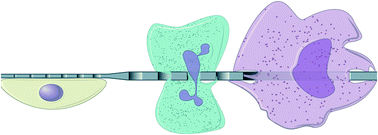Our official English website, www.x-mol.net, welcomes your feedback! (Note: you will need to create a separate account there.)
Use of porous membranes in tissue barrier and co-culture models
Lab on a Chip ( IF 6.1 ) Pub Date : 2018-05-23 00:00:00 , DOI: 10.1039/c7lc01248a Henry H Chung 1 , Marcela Mireles , Bradley J Kwarta , Thomas R Gaborski
Lab on a Chip ( IF 6.1 ) Pub Date : 2018-05-23 00:00:00 , DOI: 10.1039/c7lc01248a Henry H Chung 1 , Marcela Mireles , Bradley J Kwarta , Thomas R Gaborski
Affiliation

|
Porous membranes enable the partitioning of cellular microenvironments in vitro, while still allowing physical and biochemical crosstalk between cells, a feature that is often necessary for recapitulating physiological functions. This article provides an overview of the different membranes used in tissue barrier and cellular co-culture models with a focus on experimental design and control of these systems. Specifically, we discuss how the structural, mechanical, chemical, and even the optical and transport properties of different membranes bestow specific advantages and disadvantages through the context of physiological relevance. This review also explores how membrane pore properties affect perfusion and solute permeability by developing an analytical framework to guide the design and use of tissue barrier or co-culture models. Ultimately, this review offers insight into the important aspects one must consider when using porous membranes in tissue barrier and lab-on-a-chip applications.
中文翻译:

多孔膜在组织屏障和共培养模型中的应用
多孔膜能够在体外分隔细胞微环境,同时仍然允许细胞之间的物理和生化串扰,这一特征通常是重现生理功能所必需的。本文概述了组织屏障和细胞共培养模型中使用的不同膜,重点是这些系统的实验设计和控制。具体来说,我们讨论了不同膜的结构、机械、化学甚至光学和传输特性如何通过生理相关性赋予特定的优点和缺点。本综述还通过开发分析框架来指导组织屏障或共培养模型的设计和使用,探讨了膜孔特性如何影响灌注和溶质渗透性。最终,这篇综述深入了解了在组织屏障和芯片实验室应用中使用多孔膜时必须考虑的重要方面。
更新日期:2018-05-23
中文翻译:

多孔膜在组织屏障和共培养模型中的应用
多孔膜能够在体外分隔细胞微环境,同时仍然允许细胞之间的物理和生化串扰,这一特征通常是重现生理功能所必需的。本文概述了组织屏障和细胞共培养模型中使用的不同膜,重点是这些系统的实验设计和控制。具体来说,我们讨论了不同膜的结构、机械、化学甚至光学和传输特性如何通过生理相关性赋予特定的优点和缺点。本综述还通过开发分析框架来指导组织屏障或共培养模型的设计和使用,探讨了膜孔特性如何影响灌注和溶质渗透性。最终,这篇综述深入了解了在组织屏障和芯片实验室应用中使用多孔膜时必须考虑的重要方面。



























 京公网安备 11010802027423号
京公网安备 11010802027423号